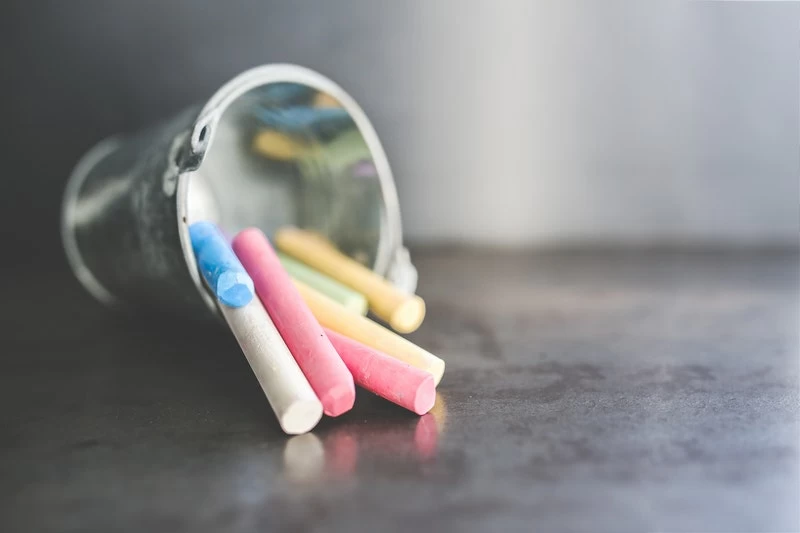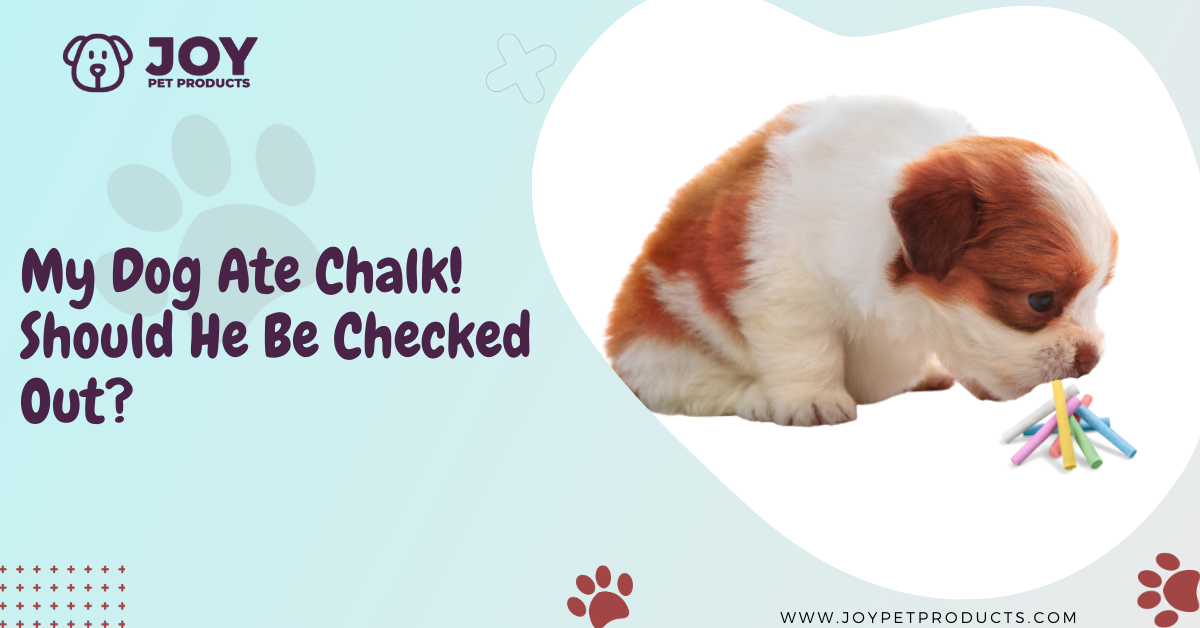Chalk has to be one of the most frequently-used materials in the world.
Commonplace in settings ranging from schools, pool lounges and sidewalks, it’s a favorite tool of adults and children alike.
However, the last place you want to see any sign of chalk or its residue is on the inside of a dog’s mouth.
That begs the question: If your dog ate chalk, what’s going to happen?
Dog owners everywhere will be happy to know that chalk is non-toxic and usually harmless when ingested.
It is possible for parts of the chalk to break down and cause temporary stomach problems, but that’s usually the maximum extent of complications experienced- at least from a chemical standpoint.
In many cases of chalk consumption by canines, they are likely to experience transient episodes of diarrhea or vomiting. Eventually, the undigested chalk should make its way through the intestines and into some particularly colorful poop.
As with most foreign object ingestion (such as if a dog ate ear plugs or LEGO pieces), the biggest dangers to look out for are choking and internal blockage.
Both choking and intestinal obstruction will require prompt action, and may also warrant an urgent visit to the vet’s office.
Can Chalk Kill A Dog?

(Side note: I am a member of the Amazon Associates program. From time to time I like to recommend products in my posts that I feel may truly be helpful to readers and their pets. If you do end up buying something by clicking the links on my site, I may receive a tiny amount of commission from the big guys.
And if you do end up buying something- Thank you! I really appreciate your support and I’ll always do my best to put out more quality content for you 🙂 )
Chalk is generally non-toxic to canines.
In small amounts, different varieties of chalk (e.g. sidewalk chalk, blackboard chalk) should not cause any significant issues after consumption.
The main component of chalk is calcium sulfate or calcium carbonate.
These are relatively non-toxic materials, but can still cause gastrointestinal (GI) issues like vomiting or diarrhea if consumed in large quantities.
What Happens If My Dog Eats Chalk?

After chomping on a chunk of chalk, most dogs will tend to go about their day as normal.
(Author’s note: I mean, this would be true of most dogs regardless of what they ate- slugs, pacifiers, or even poop!)
If there’s no noticeable difference when your dog drinks, eats or goes to the toilet after eating chalk, it should be completely fine and should eventually excrete the chalk through its feces.
As already mentioned above, some dogs may experience transient bouts of vomiting and/or diarrhea after consuming chalk. This is because pieces of chalk may break down during transit and disturb regular bowel movement.
A minor issue with some chalks is the powder residue. The powder can be a pestilence to a dog’s nasal passage or eyes, and may result in coughing or watery, irritated eyes. A quick wipe or puff to the area should get rid of it quicksmart!
More significant issues that can be associated with the consumption foreign objects involve the problems of choking and intestinal blockage.
Other than cutting off the supply of oxygen to the lungs, choking can also potentially cause other respiratory issues and a subsequent loss of consciousness.
In the case of stomach obstructions, multiple pieces or larger-sized chunks of chalk that are consumed can become stuck within the digestive tract. Smaller dogs are more susceptible to these issues than larger dogs due to narrower internal pathways.
Some of the signs of stomach blockages include:
- Vomiting
- Excessive drooling
- Loss of appetite
- Constipation
- Bloody stools (due to intestinal laceration or perforation)
- Unusual bowel movements causing discolored, inconsistent, or low amounts of stool
What If My Dog Ate Sidewalk Chalk?

Sidewalk chalk (like those from Crayola) is generally categorized as a non-toxic substance.
It is manufactured primarily for children to draw and create art- and we all know how much children like to put random objects in their mouths!
As such, dogs that eat sidewalk chalk will usually be fine.
As with most other foreign body consumption, the most troublesome consequence that could result is internal blockage.
See the above section to have a look at the potential visible signs of obstruction, which can include loss of appetite, lethargy and unusual bowel movement.
If any of these symptoms are exhibited, it would be a good idea to make a visit to the vet.
What If My Dog Ate Pool Chalk?
Pool or billiard chalk is similarly non-toxic, but the main point of difference is that some versions may contain lead.
The consequences of eating these types of chalk will depend on the quality and manufacturer, as most are made using crushed silica, corundum and occasionally aluminum oxide.
Typical symptoms of pool chalk consumption include vomiting and diarrhea as it makes its way through the dog’s digestive system.
The degree to which these symptoms are experienced will also be dependent on the amount the dog has consumed.
As previously discussed, important aspects to check for after your dog has eaten chalk include checking for blockage, determining if there is any loss of appetite, whether there is any blood in the stool, and whether the chalk has been successfully excreted.
What Do I Do If My Dog Ate Sidewalk Chalk (Or Any Other Chalk)?

If only a small amount of chalk was consumed, it is recommended to simply let it pass through your dog’s digestive tract.
Being non-toxic and typically rounded with no sharp edges. chalk should not cause much impediment.
Depending on the quantity of chalk ingested, some vets may advise you to take away food for 24 hours to let the digestive system rest. Water, however, can still be provided. After one day has passed, a small volume of food may gradually be re-introduced.
While the most likely scenario is that your dog won’t experience any adverse effects after eating chalk, it is possible for choking or other respiratory issues to arise.
In such circumstances where your dog appears to be choking, firstly check if the chalk is still somewhere inside its mouth or throat.
If there are any lodged pieces, try to remove them if you can safely do so with your fingers. If you cannot, take your dog to the vet.
If you cannot see or reach the lodged chunk, or if your dog appears to be losing consciousness, you will need to perform the Heimlich Maneuver immediately to dislodge the object from its airway.
Once you can safely establish there are no immediate respiratory issues, contact your vet or an animal safety hotline to determine the next best action.
If your dog ate moderate quantities of chalk, you could be advised by your vet to induce vomiting using 3% hydrogen peroxide.
Keep in mind that induced vomiting should never be carried out if over two hours have passed since ingestion as the chalk will already have travelled too deeply into the digestive system.
A light meal is often suggested to be given before inducement of vomit as this can make the process smoother.
For larger chunks of chalk, you will likely be advised not to induce vomiting as the chalk could very easily become stuck in the dog’s throat, causing trauma and risk of choking.
If the large chunk of chalk was eaten within the last hour, taking your dog to emergency vet services may be an option as they may be able to take out the chalk using endoscopy.
If it has been two hours or more since your dog consumed chalk and your vet has said there is nothing you can do in the current stage, you will need to monitor for signs of stomach obstruction such as:
- Vomiting
- Diarrhea
- Loss of appetite
- Lethargy
- Abnormal toilet breaks or change in stool quality
Any (or a combination) of these signs can potentially signify an internal blockage, and if observed the vet should be immediately contacted. Internal blockages can be a life-threatening issue, and surgery may be necessary to remove the chalk.
Why Would A Dog Eat Chalk?

Younger pups tend to be extremely curious, and chew on anything they can get their paws on just to have a taste.
Some dogs may be especially drawn to the strange aroma or texture that chalk has, and decide to take a chomp out of curiosity.
Boredom is also often a factor, and any foreign objects that are lying around the house can very quickly become their playthings.
Additionally, puppies in their teething stage will naturally try to bite on any solid, chewable material they can find in an attempt to reduce the inescapable discomfort they are facing. If there are chunks of chalk lying around, these inevitably become extremely appealing targets.
In rare cases, dogs can develop a condition called pica. Pica is characterized by an abnormal eating habit whereby the dog eats everything regardless of whether it is actually edible or not!
Pica can be caused by a number of different factors, including:
- Nutrient deficiency
- Electrolyte imbalances
- Starvation
- Parasites
How To Prevent A Dog From Eating Chalk
To prevent your pet pup from eating foreign objects like chalk, the first (and probably most effective) method is simply to limit their access to them.
To do this, all you need to do is put the objects somewhere they cannot reach, or store them in enclosed containers. Mom was right about tidying up your room, after all!
Another method that many people try is to spray or apply certain products like bitter apple spray to make the object in question smell or taste unappetizing. These nasty-tasting substances often have the effect of turning the canine off the object completely.
If boredom is the reason behind their chalk consumption, you can alleviate their boredom by providing safe toys that cannot be easily broken down. These include the famous KONG or Petstages DogWood chews.
As a poor diet and sedentary lifestyle can also be a reason for this behavior, it is therefore important to ensure your dog is obtaining adequate nutrition in their diet and undergoes sufficient daily mental and physical exercise.
Crate training may be a good option to look into if you are searching for a long-term way to prevent excessive chewing. This way, you can ensure that household items remain intact even when your pooch is not supervised.
Behavioral training is also an extremely important aspect of preventing a dog from eating things they aren’t supposed to. As soon as you see your dog attempt to eat any foreign material, you should immediately tell them “No” or “Leave” and make sure that they retreat.
Finally, in extreme cases of excessive consumption of inappropriate objects, you may need to resort to using a muzzle.
In Summary
If you found that your dog ate chalk, you can rest assured in the knowledge that your pup will most likely be just fine.
At the same time, though chalk is a non-toxic object it can still cause minor GI problems such as diarrhea and vomiting.
In rare cases, more serious complications such as choking or an internal obstruction can result as well.
Most of the time, the best course of action to take after a dog has eaten chalk is simply to monitor it over the next few days for any adverse signs. Different methods of treatment will be recommended depending on the symptoms that a dog displays.
For example, minor episodes of stomach distress may call for rest and abstinence from food for a day or two.
In these cases of chalk ingestion, a dog should not experience any significant issues and will typically eliminate the material from its body within a matter of hours or days.
In situations of choking or intestinal blockage, procedures such as induced vomiting, endoscopy or surgery may be required.
If any signs such as loss of appetite, constipation, or bloody stools are observed, take your pet to the vet immediately for evaluation and treatment.
Heather Abraham is a professional blogger who owns two dogs, a cat, a parrot, and a leopard gecko. She has a connection with animals since she was a child. She shares her love for all pet breeds and provides information on pet food, toys, medications, beds, and everything else.
She is committed to learning about the internal workings of animals. Her work permits her to work closely with knowledgeable vets and obtain practical expertise in animal care. When she is not working, her love of animals continues in her writing. Her goal is to educate and uplift readers who also have a passion for animals through her writing.

